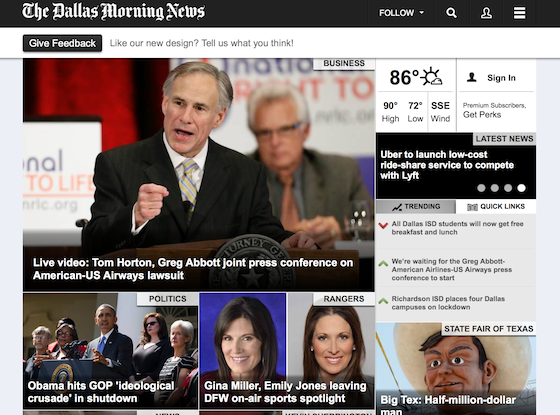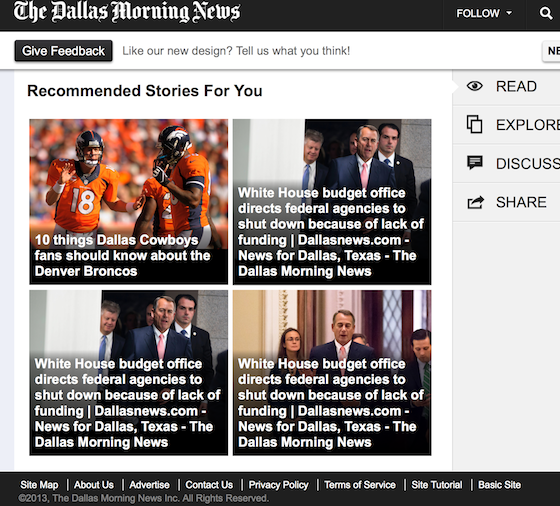In May 2009, Dallas Morning News publisher Jim Moroney told the Senate that a paywall didn’t make sense for his newspaper unless everybody else did one too:
if The Dallas Morning News today put up a paywall over its content, people would go to the Fort Worth Star-Telegram.
By January 2011, Moroney was saying this as the News launched a hard paywall:
We will be vilified by the digital futurists, ridiculed by colleagues in our industry and fitted with a dunce cap by the trade media. In fact, some of the same will be heard in our own hallways. Much like our 40% increase in home delivery pricing in 2009, this strategy goes against the grain. But that’s okay. We’ve been there before.
Moroney in April 2012 in saying he was “very satisfied” with the new paywall—which AH Belo said drew 49,000 subscribers in the first year (which if true, would be an enormous number for the first year):
We simply couldn’t afford to give away for free what our best customers were paying $400 a year to have.
Moroney in May of this year on plans to convert its hard paywall to the meter model:
“We didn’t really give people enough reasons to subscribe digitally. We made it too hard for them to subscribe digitally. We didn’t market it hardly at all.”
Monday, the News‘s marketing director had this to say:
“The pay wall solution hasn’t worked,” said Dyer of The News, whose current pay wall restricts access to premium content. “The pay wall didn’t create a massive groundswell of [digital] subscribers.”
Moroney announced that the paper was killing its paywall and creating a “premium digital experience” (read paywall) and a free site. For $12 a month, readers will get an “image-oriented, collage display with far fewer ads” that looks like this:
And:
If dallasnews.com Premium gets subs into the triple digits, it will have beaten the odds.
The execution here gives us a lead on what went wrong with the paper’s paywall, which, if you’re doing it right, should never have to be pulled down.
The News didn’t do it right. It went with a hard paywall (though it let some commodity news out for free on the site), and that’s almost always a mistake. Only the most essential news providers can pull that off, and the News is not the powerhouse paper it was 10 years ago.
It’s true that the News launched its paywall a couple of months before The New York Times showed once and for all how it’s done. But that’s no excuse for not following suit with a meter model that allows you to raise or lower your free-stories-per-month count at will in order to maximize revenue from ads and subscriptions.
The same is true for the San Francisco Chronicle, which actually had a worse strategy than the News. The Chronicle had the worst of both worlds: A site (SFGate.com) that remained totally free and a premium site with a hard paywall. It lasted four months.
But there’s no reason a newspaper should have to give up any ad revenue if it doesn’t want to. With a meter, you can set the gate at 50 or even 100 stories per month and get subscription money only from your hardest core readers while preserving unique visitors and page views. It’s free money, however meager, that way.
Better yet, if you’ve got journalism worth selling, you can set the meter at 15 stories a month and sacrifice some of your 40-cent-a-CPM remnant ads in exchange for higher subscription revenue.
The paywall is not going to save a paper’s bacon on its own. That was always a canard of the anti-paywall brigade. And better papers are going to have more success than not-so-good ones. At the Chronicle, for instance, there’s not much left to pay for. The paper’s newsroom is one-quarter the size it was in 2000.
But we’ve seen clearly now, from newspapers of all shapes and sizes, that not employing one (correctly!) means you’re leaving sorely needed money on the table.
As I said two years ago, the NYT set the template. Copy it, and stick to it.
Ryan Chittum is a former Wall Street Journal reporter, and deputy editor of The Audit, CJR’s business section. If you see notable business journalism, give him a heads-up at rc2538@columbia.edu. Follow him on Twitter at @ryanchittum.


